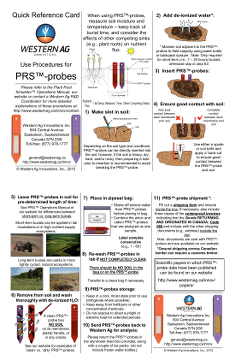PRS Technology
It is essential that the duration of PRS® Probe burial be equivalent for all treatments being compared, because this will have an effect on the amount of nutrients adsorbed. Depending on your objectives, there are either short-term or long-term PRS® Probe burials. The longer a PRS® Probe is buried, the greater the opportunity to adsorb ions released from the soil and the higher the resultant nutrient supply rates measured. Burial length is important particularly when measuring nutrients whose availability is governed primarily through biochemical reactions (i.e., N and S) rather than the size of labile pool (i.e., P and K). It is also important that the PRS® Probes not be buried for so long that the ion-exchange membrane becomes saturated. Depending on the soil type, the recommended maximum burial length of the PRS® Probes will vary.
Note: because ion adsorption is not linear, instead generally following first order kinetics over time, nutrient supply rates cannot be divided into time units smaller than the entire duration of soil burial. For example, nutrient supply rates measured over a two-week burial cannot be divided by 14 and reported in terms of per day. However, repeated measures over time in the same soil slot can be added together to achieve a cumulative nutrient supply rate (i.e., over the growing season), while providing greater resolution in terms of temporal variations in nutrient availability.
Considering that the PRS® Probes integrate all of the principal edaphic factors affecting nutrient uptake by plants, this flux measurement will change in response to changing soil conditions. Therefore, it is very important that these conditions be considered when interpreting nutrient supply rate data among sites and/or treatments. The sensitivity of PRS® Probes to conditions in situ makes them a powerful functional tool for measuring nutrient availability under conditions analogous to those in which plants grow. However, this sensitivity also demands that care must be taken in planning experiments with the PRS® Probes and when interpreting PRS® Probe nutrient supply rate data. If possible, it is recommended that at least soil moisture and temperature be measured for the duration of PRS® Probe burial and that plant root competition be accounted for.

